Shoreline Response to Wave Forcing and Sea Level Rise along a Geomorphological Complex Coastline (Western Sardinia, Mediterranean Sea)
Abstract
1. Introduction
2. Study Area
3. Data and Methods
3.1. Sediments
3.2. Beach Profiles
3.3. Wave Climate
3.4. Multibeam and Single-Beam Acquisition
3.5. Digital Terrain Model Data
4. Results
4.1. Sediments
4.2. Beach Profile Changes—Bulk Statistics
4.3. Wave Climate and Volumetric Changes
4.4. Inner Shelf Morphology
5. Discussion
6. Conclusions
Author Contributions
Funding
Institutional Review Board Statement
Informed Consent Statement
Data Availability Statement
Acknowledgments
Conflicts of Interest
References
- Morton, R.A.; Sallenger, A.H., Jr. Morphological impacts of extreme storms on sandy beaches and barriers. J. Coast. Res. 2003, 19, 560–573. [Google Scholar]
- Short, A.D. Handbook of Beach and Shoreface Morphodynamics; west Sussex PO191UD; Wiley& Sons Ltd.: Chichester, UK, 1999; ISBN 978-0-471-96570-1. [Google Scholar]
- Simeone, S.; Palombo, L.; De Falco, G. Morphodynamics of a Nontidal Embayed Beach: The Case Study of Is Arutas (Western Mediterranean). J. Coast. Res. 2013, 291, 63–71. [Google Scholar] [CrossRef]
- Short, A.D. Role of geological inheritance in Australian beach morphodynamics. Coast. Eng. 2010, 57, 92–97. [Google Scholar] [CrossRef]
- Nolan, T.; Kirk, R.; Shulmeister, J. Beach cusp morphology on sand and mixed sand and gravel beaches, South Island, New Zealand. Mar. Geol. 1999, 157, 185–198. [Google Scholar] [CrossRef]
- Mason, T.; Coates, T.T. Sediment transport processes on mixed beaches: A review for shoreline management. J. Coast. Res. 2001, 17, 645–657. [Google Scholar]
- Ivamy, M.C.; Kench, P.S. Hydrodynamics and morphological adjustment of a mixed sand and gravel beach, Torere, Bay of Plenty, New Zealand. Mar. Geol. 2006, 228, 137–152. [Google Scholar] [CrossRef]
- Horn, D.P.; Walton, S.M. Spatial and temporal variations of sediment size on a mixed sand and gravel beach. Sediment. Geol. 2007, 202, 509–528. [Google Scholar] [CrossRef]
- Karunarathna, H.; Horrillo-Caraballo, J.M.; Ranasinghe, R.; Short, A.D.; Reeve, D.E. An analysis of the cross-shore beach morphodynamics of a sandy and a composite gravel beach. Mar. Geol. 2012, 299-302, 33–42. [Google Scholar] [CrossRef]
- Orford, J.D.; Anthony, E.J. Extreme events and the morphodynamics of gravel-dominated coastal barriers: Strengthening uncertain ground. Mar. Geol. 2011, 290, 41–45. [Google Scholar] [CrossRef]
- Basterretxea, G.; Orfila, A.; Jordi, A.; Casas, B.; Lynett, P.; Liu, P.L.F.; Duarte, C.M.; Tintoré, J. Seasonal Dynamics of a Microtidal Pocket Beach with Posidonia oceanica Seabeds (Mallorca, Spain). J. Coast. Res. 2004, 204, 1155–1164. [Google Scholar] [CrossRef]
- Del Río, L.; Plomaritis, T.A.; Benavente, J.; Valladares, M.; Ribera, P. Establishing storm thresholds for the Spanish Gulf of Cádiz coast. Geomorphology 2012, 143–144, 13–23. [Google Scholar] [CrossRef]
- Sallenger, A.H. Storm impact scale for barrier island. J. Coast. Res. 2000, 16, 890–895. [Google Scholar]
- Stockdon, H.F.; Sallenger, A.H.; Holman, R.A.; Howd, P.A. A simple model for the spatially-variable coastal response to hurricanes. Mar. Geol. 2007, 238, 1–20. [Google Scholar] [CrossRef]
- De Muro, S.; Ibba, A.; Simeone, S.; Buosi, C.; Brambilla, W. An integrated sea-land approach for mapping geomorphological and sedimentological features in an urban microtidal wave-dominated beach: A case study from S Sardinia, western Mediterranean. J. Maps 2017, 13, 822–835. [Google Scholar] [CrossRef]
- Jackson, D.; Cooper, J.; Del Rio, L. Geological control of beach morphodynamic state. Mar. Geol. 2005, 216, 297–314. [Google Scholar] [CrossRef]
- Jackson, D.W.T.; Cooper, J.A.G. Geological control on beach form: Accomodation space and contemporary dynam-ics. J. Coast. Res. 2009, 56, 69–72. [Google Scholar]
- Loureiro, C.; Ferreira, Ó.; Cooper, J.A.G. Geologically constrained morphological variability and boundary effects on embayed beaches. Mar. Geol. 2012, 329–331, 1–15. [Google Scholar] [CrossRef]
- Bosom, E.; Jiménez, J.A. Storm-induced coastal hazard assessment at regional scale: Application to Catalonia (NW Mediterranean). Adv. Geosci. 2010, 26, 83–87. [Google Scholar] [CrossRef]
- Fitzgerald, D.M.; Pendleton, E. Inlet Formation and Evolution of the Sediment Bypassing System: New Inlet, Cape Cod, Massachusetts. J. Coast. Res. 2002, 36, 290–299. [Google Scholar] [CrossRef][Green Version]
- De Falco, G.; Molinaroli, E.; Conforti, A.; Simeone, S.; Tonielli, R. Biogenic sediments from coastal ecosystems to beach–dune systems: Implications for the adaptation of mixed and carbonate beaches to future sea level rise. Biogeosciences 2017, 14, 3191–3205. [Google Scholar] [CrossRef]
- Larson, M.; Kraus, N.C. Representation of nonerodible (hard) bottoms in beach profile change modeling. J. Coast. Res. 2000, 16, 1–14. [Google Scholar]
- Vousdoukas, M.; Velegrakis, A.; Plomaritis, T. Beachrock occurrence, characteristics, formation mechanisms and impacts. Earth-Sci. Rev. 2007, 85, 23–46. [Google Scholar] [CrossRef]
- Vousdoukas, M.; Velegrakis, A.; Karambas, T. Morphology and sedimentology of a microtidal beach with beachrocks: Vatera, Lesbos, NE Mediterranean. Cont. Shelf Res. 2009, 29, 1937–1947. [Google Scholar] [CrossRef]
- Swift, D.J.P. Barrier-island genesis: Evidence from the central Atlantic shelf, eastern USA. Sediment. Geol. 1975, 14, 1–43. [Google Scholar] [CrossRef]
- Zhang, K.; Douglas, B.C.; Leatherman, S.P. Global Warming and Coastal Erosion. Clim. Chang. 2004, 64, 41–58. [Google Scholar] [CrossRef]
- Fitzgerald, D.M.; Fenster, M.S.; Argow, B.A.; Buynevich, I.V. Coastal Impacts Due to Sea-Level Rise. Annu. Rev. Earth Planet. Sci. 2008, 36, 601–647. [Google Scholar] [CrossRef]
- Storms, J.E.A.; Swift, D.J.P. Shallow-marine sequences as the building blocks of stratigraphy: Insights from numerical modelling. Basin Res. 2003, 15, 287–303. [Google Scholar] [CrossRef]
- Lorenzo-Trueba, J.; Ashton, A.D. Rollover, drowning, and discontinuous retreat: Distinct modes of barrier response to sea-level rise arising from a simple morphodynamic model. J. Geophys. Res. Earth Surf. 2014, 119, 779–801. [Google Scholar] [CrossRef]
- Dillenburg, S.R.; Hesp, P.A. Coastal Barriers—An Introduction. In Engineering Geology for Infrastructure Planning in Europe; Springer Science and Business Media LLC: Berlin, Germany, 2008; pp. 1–15. [Google Scholar]
- De Falco, G.; Antonioli, F.; Fontolan, G.; Presti, V.L.; Simeone, S.; Tonielli, R. Early cementation and accommodation space dictate the evolution of an overstepping barrier system during the Holocene. Mar. Geol. 2015, 369, 52–66. [Google Scholar] [CrossRef]
- Tecchiato, S.; Buosi, C.; Ibba, A.; Del Deo, C.; Parnum, I.; O’Leary, M.; De Muro, S. Geomorphological and sedimentological surrogates for the understanding of seagrass distribution within a temperate nearshore setting (Esperance Western Australia). Geo-Mar. Lett. 2019, 39, 249–264. [Google Scholar] [CrossRef]
- Tecchiato, S.; Collins, L.; Parnum, I.; Stevens, A. The influence of geomorphology and sedimentary processes on benthic habitat distribution and littoral sediment dynamics: Geraldton, Western Australia. Mar. Geol. 2015, 359, 148–162. [Google Scholar] [CrossRef]
- Bird, E. Coastal Geomorphology an Introduction; Wiley and Sons, Ltd.: Chichester, UK, 2008; ISBN 978-0-470-51729-1. [Google Scholar]
- De Falco, G.; Molinaroli, E.; Baroli, M.; Bellaciccob, S. Grain size and compositional trends of sediments from Posidonia oceanica meadows to beach shore, Sardinia, western Mediterranean. Estuar. Coast. Shelf Sci. 2003, 58, 299–309. [Google Scholar] [CrossRef]
- Lionello, P.; Cogo, S.; Galati, M.; Sanna, A. The Mediterranean surface wave climate inferred from future scenario simulations. Glob. Planet. Chang. 2008, 63, 152–162. [Google Scholar] [CrossRef]
- Lionello, P. The Climate of the Mediterranena Region: From the Past to the Future, 1st ed.; Elsevier: London, UK, 2012; ISBN 9780124160422. [Google Scholar]
- Le Cozannet, G.; Garcin, M.; Yates, M.; Idier, D.; Meyssignac, B. Approaches to evaluate the recent impacts of sea-level rise on shoreline changes. Earth-Sci. Rev. 2014, 138, 47–60. [Google Scholar] [CrossRef]
- Marini, A.; Murru, M. Rilevamento geologico della penisola del Sinis (Sardegna centro meridionale). Rend. Semin. Fac. Sci. Univ. Cagliari 1977, 24, 95–108. [Google Scholar]
- Pinna, P. Evoluzione Naturale ed Impatto Antropico sui Sistemi Costieri Della Penisola del SINIS (Sardegna Centrooccidentale). Ph.D. Thesis, Università Degli Studi di Cagliari, Cagliari, Italy, 2015. [Google Scholar]
- Corsini, S.; Franco, L.; Inghilesi, R.; Piscopia, R. Atlante Delle Onde Nei Mari Italiani—Italian Waves Atlas; Agenzia per la Protezione dell’Ambiente e per i Servizi Tecnici: Roma, Italy, 2006; 152p.
- Balzano, A.; De Falco, G.; Simeone, S.; Sulis, A.; Antognarelli, F.; Massaro, G.; Satta, A.; Cugusi, G.; Piras, M.; Ventroni, M. Linea B-Morfodinamica della spiaggia di San Giovanni. In La Rete di Monitoraggio Per le Spiagge; Luigi, C., Ed.; Nuova Grafica Fiorentina: Firenze, Italy, 2013. [Google Scholar]
- Otvos, E.G. Beach ridges—Definitions and significance. Geomorphology 2000, 32, 83–108. [Google Scholar] [CrossRef]
- Simeone, S.; Palombo, A.G.L.; Guala, I. Impact of frequentation on a Mediterranean embayed beach: Implication on carrying capacity. Ocean Coast. Manag. 2012, 62, 9–14. [Google Scholar] [CrossRef]
- Blott, S.J.; Pye, K. GRADISTAT: A grain size distribution and statistics package for the analysis of unconsolidated sediments. Earth Surf. Process. Landf. 2001, 26, 1237–1248. [Google Scholar] [CrossRef]
- Gibbs, M.D.M.R.J. The Relationship between Sphere Size and Settling Velocity. J. Sediment. Res. 1971, 41, 7–18. [Google Scholar] [CrossRef]
- Thomas, T.; Phillips, M.; Williams, A. Mesoscale evolution of a headland bay: Beach rotation processes. Geomorphology 2010, 123, 129–141. [Google Scholar] [CrossRef]
- Thomas, T.; Phillips, M.R.; Williams, A.T. A Centurial Record of Beach Rotation. J. Coast. Res. 2013, 65, 594–599. [Google Scholar] [CrossRef]
- Thomas, T.; Phillips, M.R.; Williams, A.T.; Jenkins, R.E. Links between wave forcing, offshore islands and a macro-tidal headland-bound bay beach. Earth Surf. Process. Landf. 2014, 39, 143–155. [Google Scholar] [CrossRef]
- Dean, R.G. Heuristic models of sand transport in the surf zone. Engineering dynamics in the surf zone. In Proceedings of the First Australian Conference on Coastal Engineering, Engineering Dynamics of the Coastal Zone, Sydney, Australia, 14–17 May 1973. [Google Scholar]
- Vousdoukas, M.I.; Almeida, L.P.M.; Ferreira, Ó. Beach erosion and recovery during consecutive storms at a steep-sloping, meso-tidal beach. Earth Surf. Process. Landf. 2011, 37, 583–593. [Google Scholar] [CrossRef]
- Komar, P.D.; Gaughan, M.K. Airy wave theory and breaker height prediction. In Proceedings of the Coastal Engineering, Vancouver, BC, Canada, 10–14 July 1972. [Google Scholar]
- Karunarathna, H.; Pender, D.; Ranasinghe, R.; Short, A.D.; Reeve, D.E. The effects of storm clustering on beach profile variability. Mar. Geol. 2014, 348, 103–112. [Google Scholar] [CrossRef]
- Jiménez, J.A.; Gracia, V.; Valdemoro, H.I.; Mendoza, E.T.; Sánchez-Arcilla, A. Managing erosion-induced problems in NW Mediterranean urban beaches. Ocean Coast. Manag. 2011, 54, 907–918. [Google Scholar] [CrossRef]
- Antonioli, F.; Anzidei, M.; Amorosi, A.; Presti, V.L.; Mastronuzzi, G.; Deiana, G.; De Falco, G.; Fontana, A.; Fontolan, G.; Lisco, S.; et al. Sea-level rise and potential drowning of the Italian coastal plains: Flooding risk scenarios for 2100. Quat. Sci. Rev. 2017, 158, 29–43. [Google Scholar] [CrossRef]
- Rahmstorf, S. A Semi-Empirical Approach to Projecting Future Sea-Level Rise. Science 2007, 315, 368–370. [Google Scholar] [CrossRef]
- Church, J.A.; Clark, P.U.; Cazenave, A.; Gregory, J.M.; Jeverejva, S.; Levermann, A.; Merrifield, M.A.; Milne, G.A.; Nerem, R.S.; Nunn, P.D.; et al. Sea Level Change, in Climate Change 2013: The Physical Science Basis. In Contribution of Working Group I to the Fifth Assessment Report of the Intergovernmental Panel of Climate Change; Cambridge University Press: Cambridge, UK; New York, NY, USA, 2013. [Google Scholar]
- Jennings, R.; Shulmeister, J. A field based classification scheme for gravel beaches. Mar. Geol. 2002, 186, 211–228. [Google Scholar] [CrossRef]
- Loureiro, C.; Ferreira, Ó.; Cooper, J.A.G. Extreme erosion on high-energy embayed beaches: Influence of megarips and storm grouping. Geomorphology 2012, 139–140, 155–171. [Google Scholar] [CrossRef]
- Orford, J.D.; Carter, R.W.G.; Jennings, S.C. Control domains and morphological phases in gravel-dominated coastal barriers. J. Coast. Res. 1996, 12, 589–605. [Google Scholar]
- Klein, A.H.F.; Filho, L.B.; Shumacher, D.H. Short-term beach rotation processes in distinct headland bay beach system. J. Coast. Res. 2002, 18, 442–458. [Google Scholar]
- De Alegria-Arzaburu, A.R.; Masselink, G. Storm response and beach rotation on a gravel beach, Slapton Sands, U.K. Mar. Geol. 2010, 278, 77–99. [Google Scholar] [CrossRef]
- Cooper, J.A.G.; Masselink, G.; Coco, G.; Short, A.D.; Castelle, B.; Rogers, K.; Anthony, E.; Green, A.N.; Kelley, J.T.; Pilkey, O.H.; et al. Sandy beaches can survive sea-level rise. Nat. Clim. Chang. 2020, 10, 993–995. [Google Scholar] [CrossRef]
- Simeone, S.; Molinaroli, E.; Conforti, A.; De Falco, G. Impact of ocean acidification on the carbonate sediment budget of a temperate mixed beach. Clim. Chang. 2018, 150, 227–242. [Google Scholar] [CrossRef]
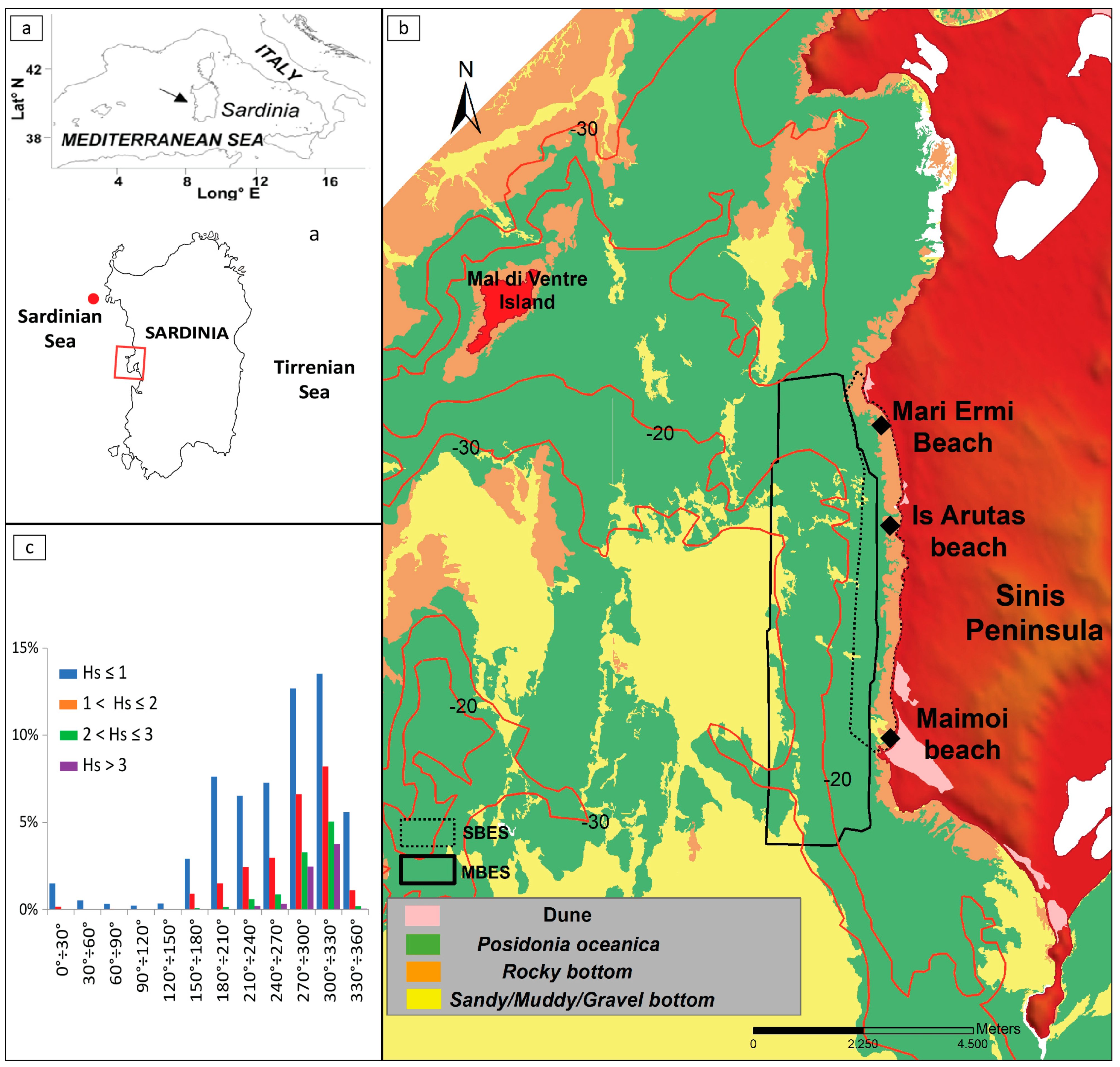
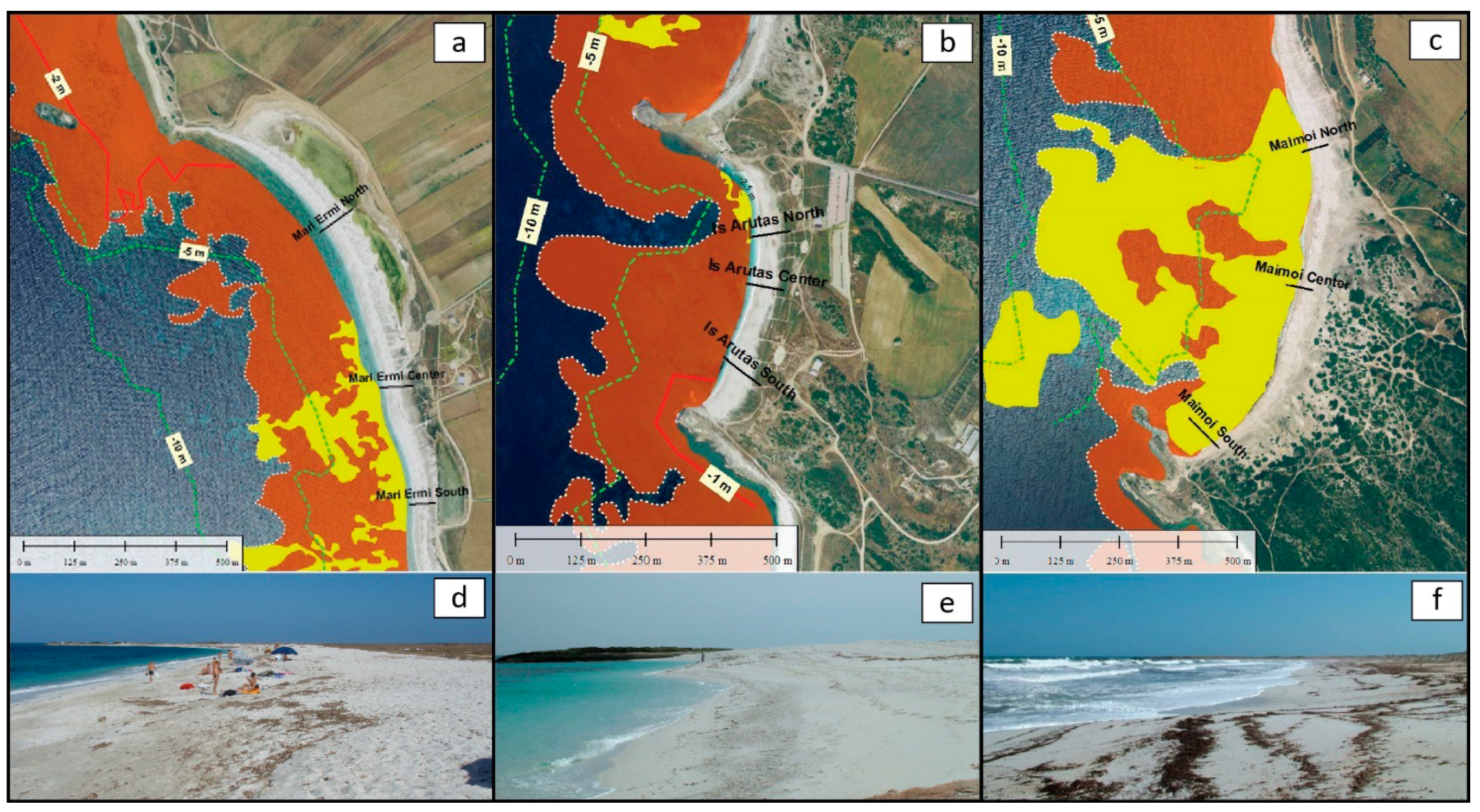
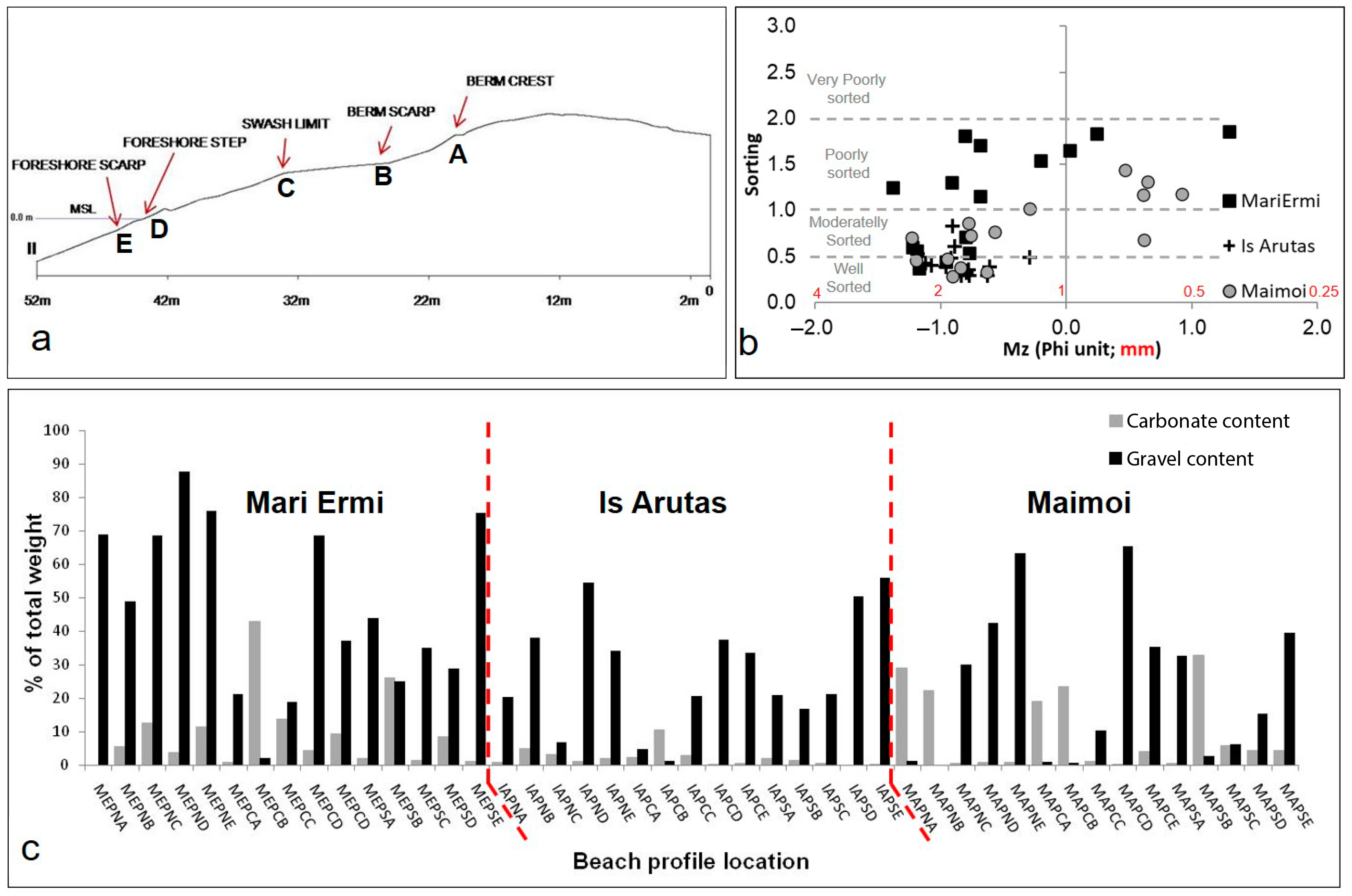
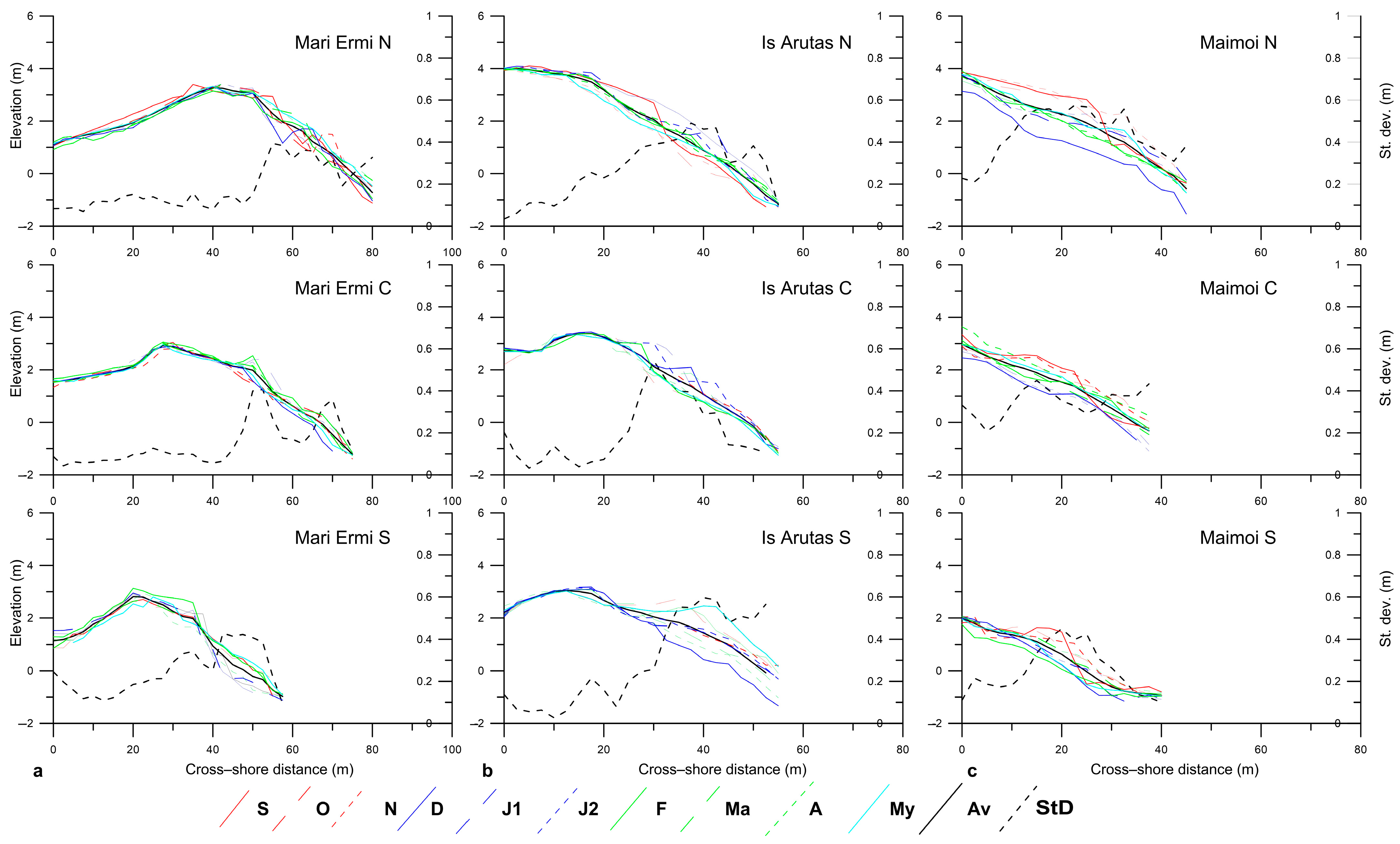
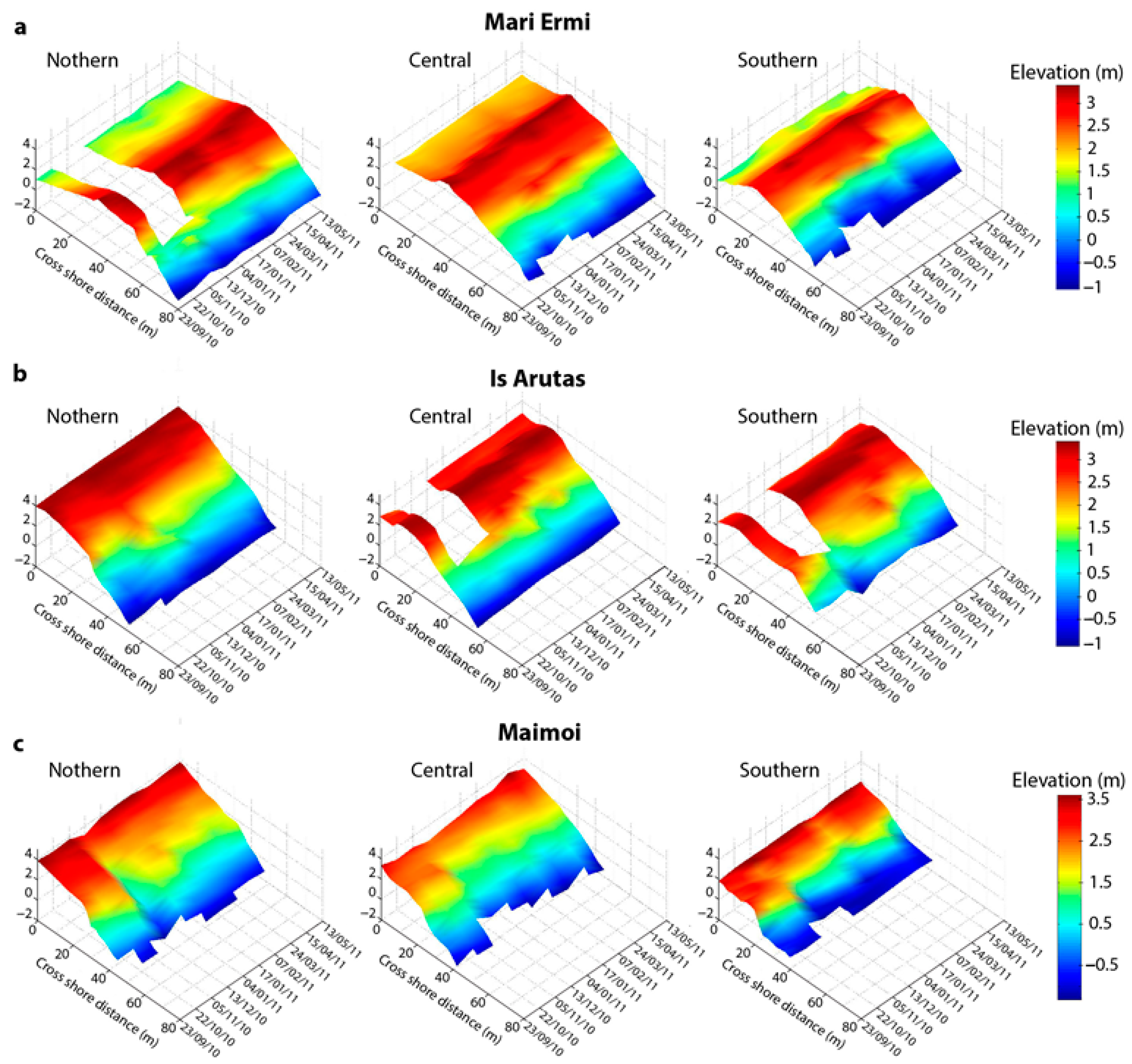
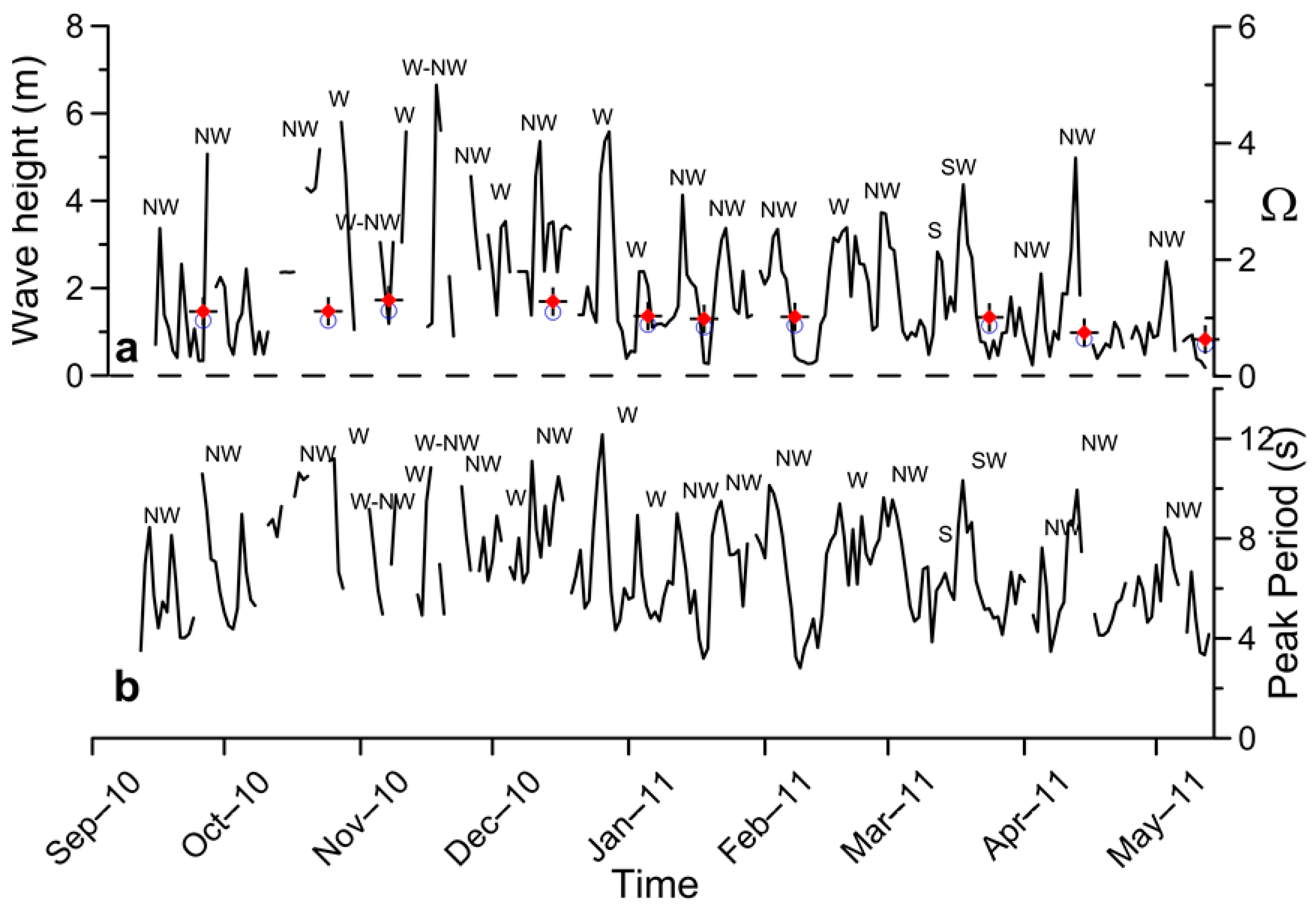


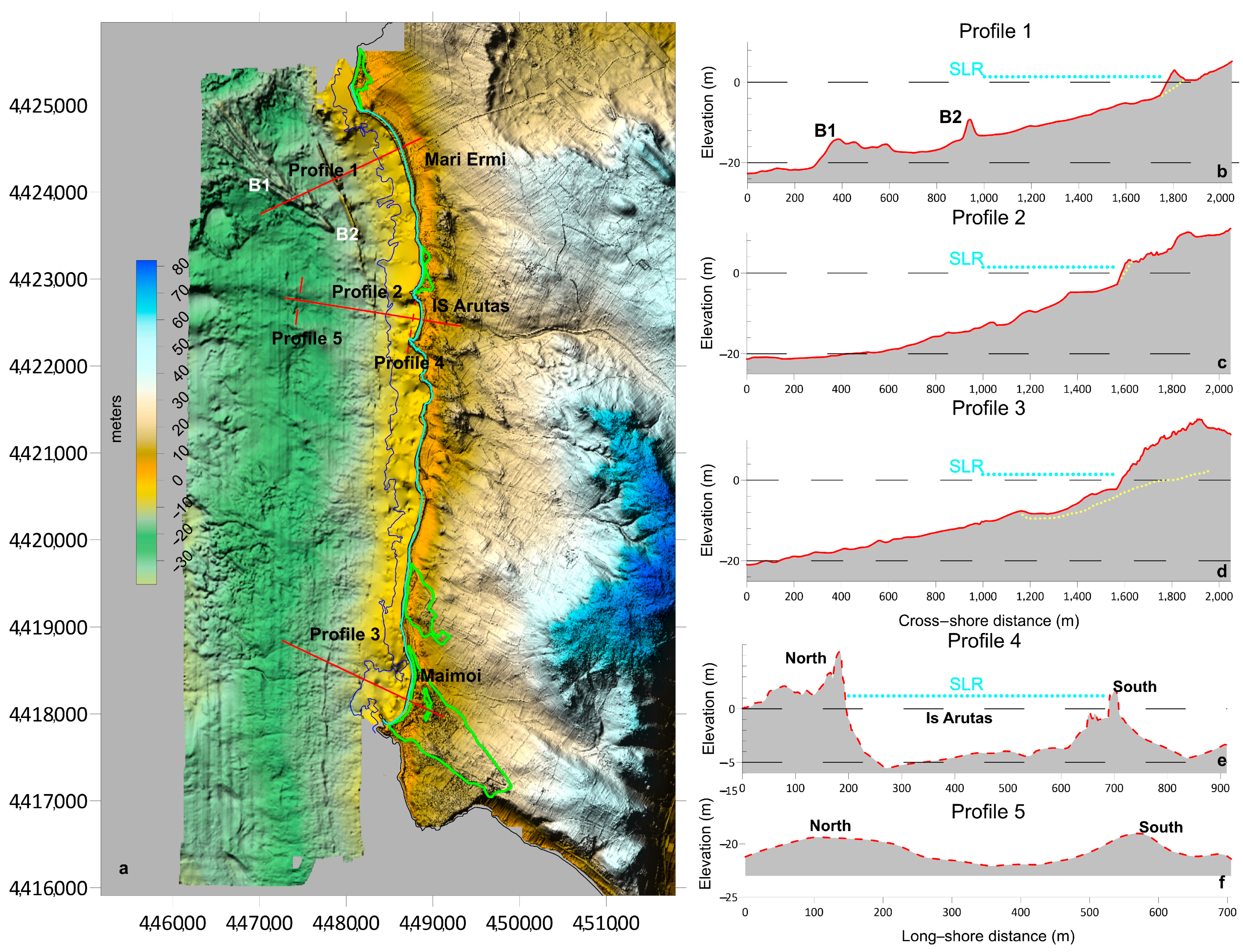
| Mari Ermi | Is Artas | Maimoi | |||||||
|---|---|---|---|---|---|---|---|---|---|
| Beach length (m) | 1200 | 500 | 1000 | ||||||
| Profiles spacing (m) | 450 | 150 | 300 | ||||||
| Profile location | Profile location | Profile location | |||||||
| North | Center | South | North | Center | South | North | Center | South | |
| Repetition | 9 | 9 | 9 | 9 | 9 | 9 | 10 | 10 | 10 |
| Profile Length (m) | 80 | 75 | 60 | 55 | 52 | 50 | 45 | 37 | 40 |
| Min depth(m) | −1 | −1 | −1 | −1 | −1 | −1 | −1 | −1 | −1 |
| d50 (mm) | 2.74 | 1.92 | 1.96 | 1.82 | 1.78 | 1.94 | 1.98 | 1.85 | 1.68 |
| ws (m/s) | 0.33 | 0.25 | 0.26 | 0.24 | 0.23 | 0.25 | 0.26 | 0.24 | 0.23 |
| Averaged ws (m/s) | 0.28 | 0.24 | 0.24 | ||||||
| Averaged ξ0 | 1.03 | 0.94 | 0.94 | 1 | 0.97 | 0.88 | 0.96 | 0.92 | 0.78 |
| Survey months | S, O, D, J1, J2, F, Ma, A, My | O, N, D, J1, J2, F, Ma, A, My | S, O, N, D, J1, J2, F, Ma, A, My | S, O, D, J1, J2, F, Ma, A, My | S, O, D, J1, J2, F, Ma, A, My | S, O, D, J1, J2, F, Ma, A, My | S, O, N, D, J1, J2, F, Ma, A, My | S, O, N, D, J1, J2, F, Ma, A, My | S, O, N, D, J1, J2, F, Ma, A, My |
| Mari Ermi Profiles Variations (m3 m−1) | Is Arutas Profiles Variations (m3 m−1) | Maimoi Profiles Variations (m3 m−1) | |||||||
|---|---|---|---|---|---|---|---|---|---|
| Survey Number | Northern | Central | Southern | Norther | Central | Southern | Northern | Central | Southern |
| O–S | −6.8 | −0.7 | −19.8 | −3.7 | −6.3 | −6.9 | 5.0 | 1.9 | |
| N–O | −8.7 | 3.2 | 14.5 | 1.1 | −1.3 | ||||
| D–N | −6.5 | −0.9 | −10.8 | 41.3 | 14.1 | −36.3 | −65.3 | −32.0 | −15.6 |
| J1–D | 6.4 | 16.0 | 4.9 | −12.1 | 7.5 | 22.2 | 38.6 | 6.3 | 4.4 |
| J2–J1 | 1.3 | −3.5 | 0.5 | −5.4 | −0.7 | 2.0 | 1.0 | −4.3 | 1.9 |
| F–J2 | −10.7 | 8.0 | 15.8 | −3.0 | −14.9 | 9.4 | −9.2 | 17.8 | −11.8 |
| Ma–F | 18.9 | −13.7 | −24.7 | 1.2 | 3.7 | −15.6 | −0.1 | −6.5 | 17.6 |
| A–Ma | −1.7 | 2.6 | 5.4 | −1.4 | −2.7 | −9.1 | −1.5 | 24.6 | 4.0 |
| My–A | 3.1 | −7.2 | 7.4 | −12.1 | 0.5 | 6.0 | 10.7 | −15.0 | −13.1 |
Publisher’s Note: MDPI stays neutral with regard to jurisdictional claims in published maps and institutional affiliations. |
© 2021 by the authors. Licensee MDPI, Basel, Switzerland. This article is an open access article distributed under the terms and conditions of the Creative Commons Attribution (CC BY) license (https://creativecommons.org/licenses/by/4.0/).
Share and Cite
Simeone, S.; Palombo, L.; Molinaroli, E.; Brambilla, W.; Conforti, A.; De Falco, G. Shoreline Response to Wave Forcing and Sea Level Rise along a Geomorphological Complex Coastline (Western Sardinia, Mediterranean Sea). Appl. Sci. 2021, 11, 4009. https://doi.org/10.3390/app11094009
Simeone S, Palombo L, Molinaroli E, Brambilla W, Conforti A, De Falco G. Shoreline Response to Wave Forcing and Sea Level Rise along a Geomorphological Complex Coastline (Western Sardinia, Mediterranean Sea). Applied Sciences. 2021; 11(9):4009. https://doi.org/10.3390/app11094009
Chicago/Turabian StyleSimeone, Simone, Luca Palombo, Emanuela Molinaroli, Walter Brambilla, Alessandro Conforti, and Giovanni De Falco. 2021. "Shoreline Response to Wave Forcing and Sea Level Rise along a Geomorphological Complex Coastline (Western Sardinia, Mediterranean Sea)" Applied Sciences 11, no. 9: 4009. https://doi.org/10.3390/app11094009
APA StyleSimeone, S., Palombo, L., Molinaroli, E., Brambilla, W., Conforti, A., & De Falco, G. (2021). Shoreline Response to Wave Forcing and Sea Level Rise along a Geomorphological Complex Coastline (Western Sardinia, Mediterranean Sea). Applied Sciences, 11(9), 4009. https://doi.org/10.3390/app11094009









